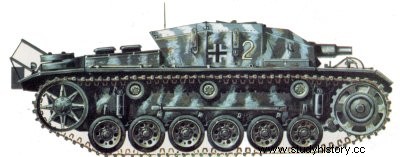
StuG III Shotgun 7.5 cm Cannon or SdKfz 142
also germany
Type : assault cannon.
Crew : 4 men.
Weaponry: a 7.5 cm Stu K 37 L/24 cannon
Shield :minimum 30 mm; maximum 90 mm.
Dimensions :
length: 5.49 m;
width : 2.95 m :
height. 1.94 m.
Weight : 22 t.
Soil pressure : 0.97 kg/cm2.
Mass power : 13.86 cents
Engine :
Water-cooled gasoline Maybach HL 120 TRM V-12, developing 300 hp to 3,000 tr/mn.
Performances :
speed on road : 40 km/h;
all-terrain speed :24 mph;
autonomy 164 km :
vertical obstacle :0.6 m :
fresh cut :2.3 m;
guy : 0.8 m
paint 30%.
Service time :in the German army from 1940 to 1945.
Having specified in 1936 what range of tanks met the army’s needs, the Wehrmacht Ordnance Service received the order to add a direct support armored vehicle to it. Daimler developed the chassis and Krupp the gun. The specification called for a low silhouette and a high-calibre barrel.
The piece chosen was a 7.5 cm short tube and the need to reduce to a minimum the height fit mount the weapon in the hull rather than on the hull.
On a chassis of PzKpfw III, the turret was replaced by a very low fixed superstructure going up to the driver's plate The gun was installed such that the muzzle came off this plate and was slightly sported on the right side of the vehicle .
The driver kept the same position. to this difference near which he now found himself seated before a vast combat room housing the three servants of the cannon Forty-four shells were ranged along the walls. The engine was not equipped with any machine guns for close range defense or secondary target handling.
The overall silhouette met the original specification very well and the shielding was strong good, by the standards of the time. Unusual characteristic for an assault cannon the roof shielding reached the 10 mm.
Only five engines were ready for the French invasion but, by the end of 1940, production had reached 184 units and deliveries were running at the rate of 30 per month. The industry put sustained this cadence until the end of 1941 when production flashed but it then resumed to pursue itself until March 1945 for the latest versions.
Early in 1942. the Model F fit its appearance, riding a 7.5 cm long tube and endowed with a complementary blind
dage on the hood. The 7.5 cm of the Model G lengthened yet again, up to 48 calibers. The engine now mounted an external machine gun for close defense and antiaircraft protection.
From 1943. all models carry armored skirts to protect the bearing train from hollow loads.
On the Model G, the superstructure was enlarged to accommodate the longer tube piece and a command dome appeared on the left rear. The final versions behaved with partially cast superstructures and large cast mantles; in addition, the frontal plates were reinforced by overlapping. Fumigant pot-launcher tubes were fixed on either side.
Towards the end of 1941, the armament was strengthened, the chassis then carrying the Stu H 42 10.5 cm howitzer , with, for mission.
the close support of infantry and armored formations. This weapon was in this role the standard artillery equipment; it could give only limited performance in antitank combat.
The engine retained virtually the same superstructure but lack of space reduced the carrying capacity to 36 shells and some chassis were converted into ammunition carriers. The StuG III was for the Wehrmacht the ideal assault cannon, relatively simple in design, well shielded. very mobile. It was to become somewhat overclassified towards the end of the war but. by March 1945, more than 10,500 units were factory output.
